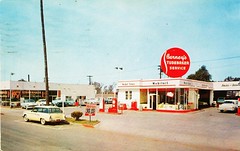Ever have a car door swing shut on your shin? Foot? Hand? You thought you had it held open by the door check (that friction device that keeps the door from swinging shut while you're fiddling with something inside), but the check was broken and didn't work right. If you've got an old car, chances are it's happened to you. With GM cars, it's usually a broken or missing spring in the hinge assembly itself, but with Studebakers, the door check is a separate piece that's easy to change out in about 10 minutes.
Here's a Studebaker door check. It's a steel strap that is held to the door hinge pillar with a soft metal pin. The way it works is that two spring-steel "fingers" on the top and bottom of the strap pinch the center bar, preventing the door from slipping closed on its own when it's fully opened.
On Barney, however, the driver's side check was broken: the lower "finger" had long ago broken off, exerting no friction on the strap, which let the door slam my shin (and forearm, and head) many times as I worked inside the car. This part is not reproduced, but is used on many years of Studes from the Fifties through 1966. Finally, I found a good used check assembly for sale on eBay and proceeded to fix the problem.
Besides the new door check, you'll also need one small part from Studebaker International: the soft metal pin that holds the check to the hinge pillar. This is Studebaker part number 1327195, and will cost you a big $2.00. One is all you'll need.

Start by pulling the interior door panel off. To do this you'll need to remove the arm rest (if equipped), and the window and door lock handles. (
See my prior post here for more on removing the door panel, if needed.) Once the panel is off, you'll be able to look into the door and easily see the back end of the door check, with its rubber bumper.

To remove the old door check, you must drive out the old door check pin. The factory secured these pins by flaring them at the bottom, so grab the bottom of the pin with a pair of pliers and squeeze the soft metal inward. Rotate the pin and do this several times, until you can push the pin upward with your fingers.
Then, use a drift to drive the pin the rest of the way up through the check assembly. A couple of raps with a small hammer should do the trick. Once the pin is out, the check assembly can simply be pulled out through the interior of the door.
Installing the new check is even simpler than getting the old one out. You just feed the check strap through the slot in the door that the old one came out of. Mate the check with the hardware mounted in the hinge pillar, and slide the new check pin downward through the assembly. Hold it in with a pair of pliers and flare the bottom of the pin using a Philips screwdriver or some other appropriate tool.
You're done! The new check is in and ready to stand sentinel against unfettered door closure. Finally, after three years, my driver's door opens and secures with a satisfying
"snick." The only thing left to do is shoot the check strap with a bit of lithium grease and put a drop of oil on the pin.
I wish they were all this easy!
Labels: My Lark, Repair









